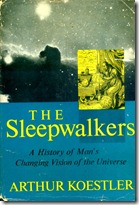Arthur Koestler’s masterpiece ‘The Sleepwalkers: A History of Man’s Changing Vision of the Universe’ is a book that I have re-read every 10 years or so, and have regularly given to young people – usually for 18th or 21st birthdays – in the probably mistaken belief that it will help them understand their world a little better.
Together with Joseph Conrad, Koestler is one of those rare people who can write with absolute clarity and great elegance in a language that he learned later in life (in Koestler’s case, English was his fourth language). ‘Sleepwalkers’ presents an account of man’s slow but sure realisation that the Earth is not at the centre of the universe but instead is a bit-player in bit galaxy out near the edge of a larger scheme of things.
Koestler explains that rather than sleepwalking into the future, over the years close and sometimes painful research and observation has led us to a better understanding of the reality of our place in the cosmos. He likens this journey to sleepwalkers slowly waking and comprehending their surroundings.
The world for many training and learning and development professionals is analogous to that of the ancient astronomers and philosophers. They understand clearly that the things are unfolding. They can see that sometimes the prior logic of their world doesn’t add up. They also understand that there are implications for the way they view their universe, but many feel they don’t have enough clarity and direction to know what to do and how to respond to the changing situation.
In the words of a more recent philosopher of popular culture, many training and development professionals realise that:
‘something is happening here, but you don’t know what it is, do you, Mr Jones’
Ballad of a Thin Man
Some Basic Truths
Despite the sentiment above, there are some emerging truths that can help learning and development professionals better understand the world of workforce development and provide them with some help in focusing their efforts and responding appropriately.
Continuous Learning
The first truth is that in an ever-changing world, continuous learning is the only sustainable advantage. My colleague in the Internet Time Alliance, Jay Cross, has been making this point for at least the past 10 years.
The world we live in is certainly ever-changing. Most knowledge workers, people who earn their living with their heads rather than with their hands, especially confront this fact every day of their working lives.
If learning and development professionals are to really add value to their organisations they need to adopt ways of working that respond effectively to increased levels of change and to supporting always-on working and learning patterns. They need to understand that learning is a continuous process and not simply a string of events, and that working and learning are merging. The implications of these facts is that the ‘course, curriculum’ mindset must be replaced by one focused on providing a supporting architecture for learning to be leveraged at any, and every, point in workers’ lives.
Action Speaks Louder than Anything
A second basic truth impacting learning and development professionals is that today’s productivity is measured not by what workers know, but by what they can do. Productivity is measured by actions and outputs, not the knowledge in people’s heads. If we have the ‘know what’ but not the ‘know how’ we will almost inevitably fall short in terms of performance.
It today’s world the ‘know who’ is also vital.
We need to store knowledge in our outboard brains – not only in databases, intranets and on the Internet, but also in the experience and insights of our co-workers, colleagues and people networks. Knowing who to ask when confronting a challenge is absolutely vital in our interconnected world.
Despite this, many traditional learning and training approaches are still focused on knowledge and content – the ‘know what’ – to the exclusion of the ‘know how’ and the know who’.
Knowledge acquisition may have its own particular personal value, however if it doesn’t result in behaviour change it is not really ‘learning’.
There have been many attempts to define learning and multiple points-of-view whether they be based in genetics, psychology, neuroscience, even educational philosophy and practice. However, no matter how one defines the process, learning can only be measured in a repeatable way in terms of behaviour change, sustained behaviour change at that.
“Learning is the ability to acquire new ideas from experience and retain them as memories”
(Eric Kandal, Columbia University, Nobel Laureate for work on learning & memory)
Experience Trumps All
A third basic truth is that most of the learning that occurs for working adults happens outside formal learning environments.
And most of this is through the experiences we have as part of our work and through practice, conversations and reflection.
Like Koestler’s Sleepwalkers, this unfolding realisation is presenting us with new perspectives on the role learning and development can, and should, play in building capability.
Although formal learning environments can provide experiences when designed well, most are still focused on information and content transmission. Learning and development departments will serve their organisation far better if they focus on using formal learning to do what it is best at – helping workers grasp core details of new jobs or roles, or key concepts in those jobs and roles (whether they be management or task-specific) – rather than trying to fill heads with detailed information and task-based ‘knowledge’ that often only persists in short-term memory as long as an end-of-course assessment before the Ebbinghaus forgetting curve takes over.
The lesson here is for learning and development people to approach their jobs more as gardeners or architects than as dispensers of information and ‘knowledge builders’. They should be creating the best possible environments for workers to develop as part of their work. they should also be looking to construct frameworks that shorten the process.
As my colleague, Harold Jarche says “learning is the work”. Never truer words spoken. Harold also points out that collaboration is also the work in our connected world.
This being the case, learning and development professionals need to focus on helping workers best engage the workplace and their colleagues for learning.
The Implications for Learning and Development
Paraphrasing Andrew McAfee’s comments about Web 2.0 and the changing ways of work:
If you’re a learning and development person who essentially views their job as one of controlling and managing learning activities and learning events you should be rather frightened by these trends. They are going to make your life more difficult and there’s no future respite for you on the horizon. In fact, things are going to get worse.
If you’re a learning and development person who views their job as someone who’s responsible for outputs and results and for supporting organisational development, innovation and improvement, then you’re going to find these trends playing to your strong suit. All the evidence points to this becoming an important role in organisations. Learning and development is well-positioned to play a part in this.
One key characteristics needed by learning and development professionals if they are to thrive and ride the wave of change that is happening was neatly summed up by John Seely Brown in his keynote at the DevLearn conference in San Francisco just yesterday:
“It requires a resilient mindset and ability to change, adapt, re-conceptualise and engage in deep listening with humility, and to get out of your comfort zone”
John Seely Brown
Seely Brown was speaking about workers generally, but these behaviours apply especially to learning professionals.
 ConsultMember of the Internet Time Alliance and Co-founder of the 70:20:10 Institute, Charles Jennings is a leading thinker and practitioner in learning, development and performance.
ConsultMember of the Internet Time Alliance and Co-founder of the 70:20:10 Institute, Charles Jennings is a leading thinker and practitioner in learning, development and performance.
I work in an organisation that employs approx 140,000 colleagues internationally, across multi-brands, diverse delivery channels, silo divisions and entrenched in habitual learning strategies that many would see as being 'controlling and managing'. Have you any great role model organisations that you would say have woken from the Sleepwalk that those of us who wish to follow suit could learn from?
One example I'd point to is British Telecom's Dare2Share approach. The CLO there, Peter Butler, moved the model from L&D being designers, developers and deliverers of training to being supporters and facilitators of worker learning experiences. Have a look at this YouTube Video of the initiative. http://www.youtube.com/watch?v=gtVYkEdGtfo
Or read this paper: http://bit.ly/9ZBPbX
Nice post Charles 🙂
Greetings from London
Mary